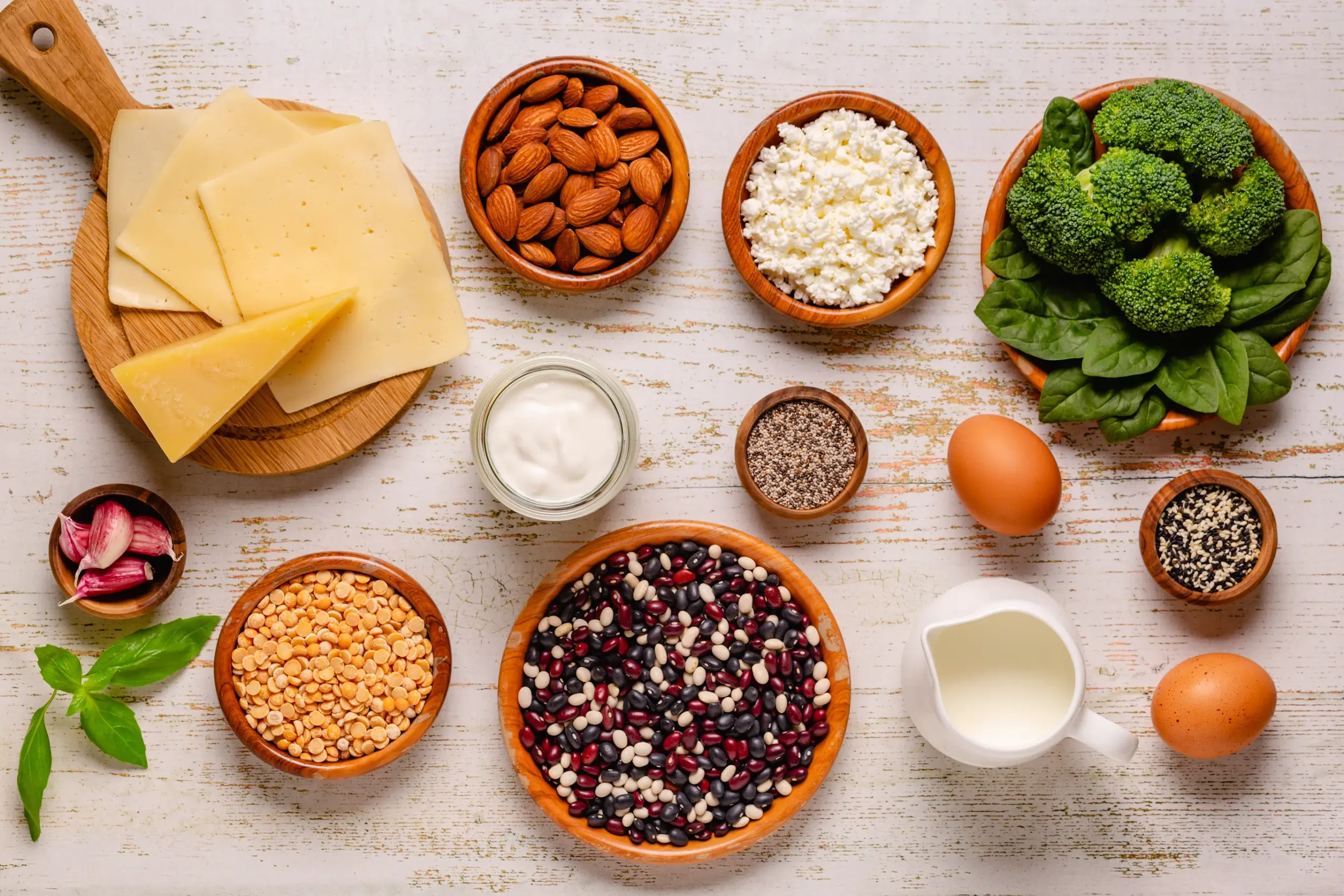
Calcium-Rich Foods for Menopausal Women: Essential Nutrition for Stronger Bones and Overall Health
Calcium-rich foods play a vital role in supporting strong bones, muscle function, and overall well-being. For menopausal women, ensuring adequate calcium intake becomes even more critical, as the decline in estrogen levels reduces the body’s ability to absorb calcium efficiently. This hormonal shift can lead to bone loss and a significantly higher risk of osteoporosis—a condition that weakens bones and increases the likelihood of fractures. Bone loss during menopause often occurs silently, without obvious symptoms. Women may not notice a problem until they experience fractures, especially in vulnerable areas like the hips, spine, and wrists. That’s why understanding how menopause affects calcium metabolism—and taking proactive steps to include more calcium-rich foods in the diet—is essential to preserving mobility and health as women age.
The Role of Calcium in Menopause
Calcium-rich foods are essential not only for maintaining bone strength but also for supporting nerve transmission and muscle contraction, including the proper functioning of the heart. During menopause, falling estrogen levels disrupt the body’s calcium balance. Estrogen normally promotes calcium absorption in the intestines and reduces calcium loss through urine. With its decline, the body begins to pull calcium from bones, weakening them over time.
This can result in conditions like osteopenia (low bone density) and osteoporosis. But calcium deficiency doesn’t stop at bones—it can also cause muscle cramps, brittle nails, tooth decay, joint pain, and even neurological symptoms like numbness or irregular heart rhythms. Meeting daily calcium requirements through calcium-rich foods is essential for supporting both bone and overall health during this stage of life.
How Menopause Affects Calcium Needs
As women transition into menopause, the body’s ability to absorb and retain calcium diminishes. This increases the risk of bone thinning and fractures, especially without dietary adjustments or supplements. Including calcium-rich foods in your diet becomes crucial to counter these changes and support bone health.
The Impact of Estrogen Decline on Calcium Absorption
- Estrogen decline reduces calcium absorption in the intestines.
- Bone resorption (the breakdown of bone tissue) increases, pulling calcium from bones.
- Bone loss accelerates during perimenopause and continues postmenopause.
- Without intervention, this process leads to brittle bones, frequent fractures, and decreased mobility.
Signs of Calcium Deficiency in Menopausal Women
Calcium deficiency often progresses silently, making it hard to detect until more serious symptoms arise. For menopausal women—already vulnerable to bone loss—recognizing early signs is vital for prevention and timely intervention. Common warning signs include:
- Bone pain or tenderness – A persistent, dull ache in the bones, especially the spine, hips, and legs, can signal weakening bone density.
- Frequent fractures from minor falls – Bones become fragile and more prone to breaking, even from routine activities or minimal impact.
- Joint pain and stiffness – Reduced calcium levels may contribute to joint discomfort, limiting mobility and increasing fatigue.
- Muscle cramps and weakness – Calcium plays a key role in muscle contraction; deficiency may cause painful cramps, spasms, or generalized weakness.
- Dental issues – Weak teeth, receding gums, or bleeding can be early signs that calcium is being pulled from teeth and bones.
- Brittle nails and dry skin – These are subtle but visible indicators of poor calcium status and overall mineral imbalance.
Why Calcium Intake Needs to Increase Postmenopause
As women age, especially after menopause, the natural decline in estrogen disrupts the body’s ability to maintain calcium balance. This makes consistent intake of calcium-rich foods and supplements increasingly important.
- Women aged 40–50 (perimenopause): Should aim for 1,000 mg of calcium daily to maintain bone strength as hormonal changes begin.
- Women 50+ (postmenopause): Need at least 1,200 mg daily, as bone loss tends to accelerate rapidly without estrogen.
- Women with osteoporosis or high fracture risk: May require up to 1,500 mg daily, but this should be taken only under medical supervision to avoid over-supplementation.
However, calcium alone isn’t enough. Your body needs the right partners and practices to use it effectively:
- Vitamin D: Essential for calcium absorption in the intestines. Without adequate vitamin D, much of your calcium intake goes unused.
- Magnesium & Phosphorus: Work synergistically to help calcium bind to the bone matrix, contributing to stronger, denser bones.
- Weight-bearing exercises: Activities like walking, resistance training, and yoga are crucial. They signal your bones to grow stronger and retain density. Regular movement not only preserves bone strength but also improves balance and coordination, reducing fall risk.
Best Calcium-Rich Foods for Menopausal Women
Getting enough calcium-rich foods during menopause is vital for preserving bone density, preventing fractures, and supporting muscle and nerve function. While dairy remains a go-to, there are many nutrient-dense, non-dairy, and plant-based sources—especially within Indian diets—that can help meet daily calcium requirements naturally.
1. Dairy Sources
Dairy is one of the most effective ways to absorb calcium, especially when paired with vitamin D.
- Milk (Cow, Buffalo, A2): A classic staple that’s rich in highly absorbable calcium, ideal for daily consumption in teas, smoothies, or plain.
- Curd/Yogurt (Dahi): Offers not only calcium but also gut-friendly probiotics, improving digestion and nutrient absorption.
- Paneer: High in both protein and calcium, making it perfect for Indian curries, tikkas, and snacks.
- Cheese: Offers concentrated calcium, though best consumed in moderation due to its higher sodium and fat content.
2. Non-Dairy Indian Calcium-Rich Foods
Many traditional Indian ingredients are naturally rich in calcium and easy to incorporate into daily meals.
- Leafy Greens (Palak, Methi, Sarson, Amaranth): These greens are packed with calcium and can be used in dals, sabzis, parathas, or theplas.
- Sesame Seeds (Til): A calcium powerhouse—great in ladoos, chutneys, or sprinkled over salads.
- Ragi (Finger Millet): One of the most calcium-rich grains, perfect for rotis, idlis, porridges, or snacks like ragi ladoos.
- Almonds & Figs: Portable and delicious, both are calcium-rich foods ideal for snacking, blending into smoothies, or topping on oats.
- Tofu & Soy Products: Versatile, protein-packed, and calcium-rich—ideal for stir-fries, gravies, or tofu bhurji.
3. Calcium-Fortified Foods
When dietary sources are limited, fortified foods can help bridge the gap.
- Fortified Plant-Based Milks (Soy, Almond, Oat): Widely available in urban stores and often enriched with both calcium and vitamin D.
- Fortified Flours & Cereals: Look for calcium-enriched atta or multigrain mixes designed for improved bone health.
- Fortified Juices: Such as orange juice with added calcium—helpful for those with dairy intolerance.
4. Fish & Seafood
Non-vegetarian calcium-rich foods offer added benefits like vitamin D and omega-3 fatty acids.
- Sardines & Anchovies: Small fish eaten whole (with bones) are incredibly calcium-dense and perfect in curries or dry-fry dishes.
- Indian Salmon (Rawas): Offers calcium along with vitamin D—essential for postmenopausal bone health.
- Shrimp & Shellfish: Rich in calcium, magnesium, and protein—great for seafood-based Indian dishes.
Calcium Supplements: Are They Necessary?
Ideally, your calcium should come from calcium-rich foods, but supplements may be required when:
- Your diet lacks sufficient calcium due to lactose intolerance, allergies, or strict veganism.
- You’ve been diagnosed with osteopenia, osteoporosis, or have a family history of bone disease.
- Medications or medical conditions (like thyroid disorders) interfere with calcium absorption.
Choosing the Right Type of Supplement:
- Calcium Carbonate: Cost-effective and provides a high calcium dose—best taken with meals.
- Calcium Citrate: Easier to absorb, especially for older adults or those with low stomach acid.
Note: Always consult a healthcare provider before starting any supplements, especially if you’re taking other medications or have kidney conditions.
Potential Risks of Too Much Calcium
While calcium is essential, excess—especially from supplements—can lead to health issues:
- Kidney Stones: High supplemental calcium may contribute to calcium-based stones.
- Heart Health Concerns: Some studies suggest excess calcium may lead to arterial calcification.
- Digestive Discomfort: Such as constipation, bloating, or gas.
To stay safe, prioritize calcium-rich foods and stick to recommended daily allowances unless advised otherwise by a doctor.
Bone Health Beyond Calcium: A Holistic Approach
Strong bones aren’t built on calcium alone. Hormonal balance, physical activity, and overall lifestyle play critical roles in preserving bone mass and preventing age-related bone loss.
1. Exercise
Regular movement helps your bones stay strong and responsive.
- Weight-Bearing Exercises: Brisk walking, dancing, hiking, and climbing stairs signal your bones to strengthen.
- Strength Training: Using resistance bands, weights, or even body weight improves bone density and muscle mass.
- Balance & Flexibility: Yoga, tai chi, and Pilates improve coordination, helping reduce fall-related injuries.
2. Hydration & Collagen Support
Joints and bones need adequate hydration to remain lubricated and flexible.
- Hydration: Drink 2–3 liters of water daily to support cellular repair and joint health.
- Collagen-Rich Foods: Bone broth, egg whites, fish, and citrus fruits help maintain connective tissue and cartilage.
3. Stress & Hormonal Balance
Chronic stress increases cortisol levels, which can interfere with bone rebuilding and worsen menopausal symptoms.
- Mind-Body Practices: Incorporate meditation, deep breathing, or guided relaxation.
- Gentle Movement: Slow walks in nature, stretching, or light yoga help regulate hormones and reduce anxiety.
For menopausal women, calcium-rich foods play a vital role in preserving bone strength, preventing fractures, and supporting overall well-being. By including a balanced mix of natural, fortified, and diverse sources—alongside regular exercise, stress management, and smart supplementation—women can take proactive steps to protect their bones during this important phase of life.
Strong bones start with smart choices—begin with your plate.
FAQs
Bone loss during menopause tends to be rapid and silent, occurring without noticeable symptoms until a fracture happens. This makes early prevention and regular calcium intake especially critical.
Signs of calcium deficiency include bone pain, frequent fractures, joint stiffness, muscle cramps, and brittle nails. If unsure, consult a healthcare provider or dietitian for a personalized assessment.
Yes, especially through supplements. Excess calcium can lead to kidney stones, constipation, and even heart-related issues. It's best to focus on balanced intake from calcium-rich foods and take supplements only if prescribed.
Not always. Supplements are useful when dietary calcium is insufficient or if there's a diagnosed deficiency. Always consult a doctor before starting them to avoid unnecessary risks.
Ensure adequate vitamin D, engage in regular weight-bearing exercise, and include magnesium- and phosphorus-rich foods. These factors help the body absorb and utilize calcium more effectively.

Sonakshi Kandhari





